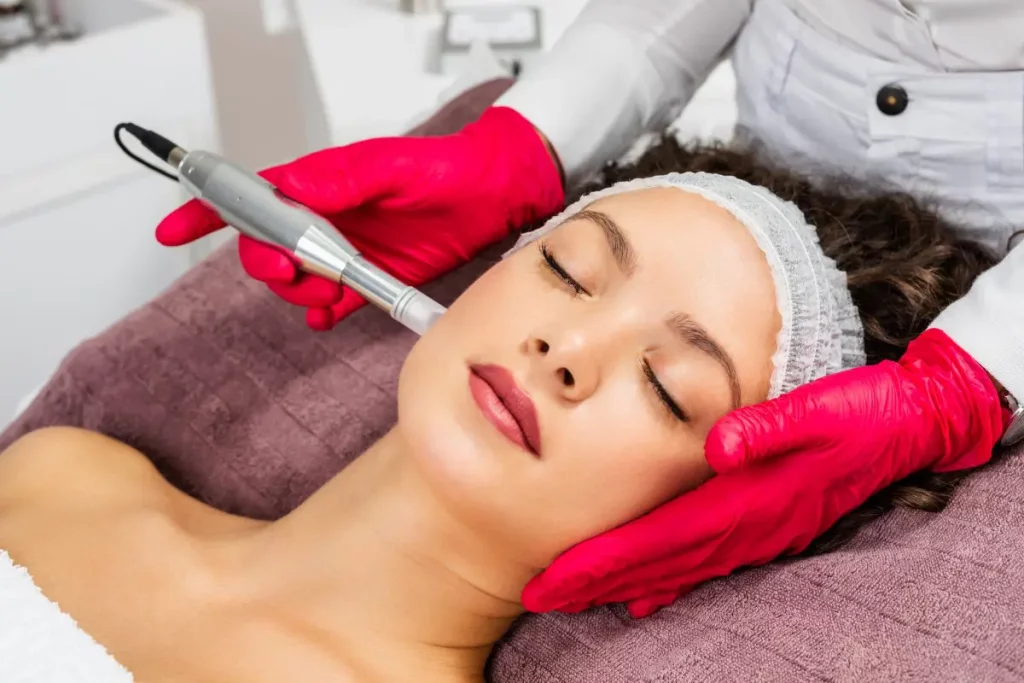at Omniya Clinic in London
Microneedling is based on the principle that there is a release of growth factors once the stratum corneum is pierced. Stratum corneum is the term that is used to describe the outermost layer of the epidermis. These growth factors are deemed to be responsible for treating a number of different conditions. The treatment will enhance your skin by increasing collagen production, as well as making it thicker and stronger and facilitating natural repair and growth.
Key treatment area for problematic skin that micro-needling can treat are – pigmentation, acne scars, wrinkes and anti-ageing and rosacea.

Pigmentation happens in two different ways – inflammatory and passive. The former occurs due to the natural defence mechanisms activating in our skin. Our melanin moves up to defend against trauma that has been caused due to factors like injury, poor products, and sunlight. On the other hand, there is passive pigmentation. This happens because of an internal imbalance that stimulates the hormone that stimulates melanin. These imbalances can be caused due to various medications, the contraceptive pill, hormonal imbalances, and pregnancy. Microneedling can be used in order to correct pigmentation by enhancing the availability of skin lightening actives.
A considerable proportion of acne sufferers are going to have some type of scarring to show for it. Medical studies have indicated that there has been between 30 and 95 per cent of patients that will have scarring from acne. Microneedling helps reduce the severity and the risk of acne scars. Existing scarring will be mechanically broken down, with the production of collagen and elastin being stimulated. These are two components that are critical for healthy skin. You will notice an immediate glow, and the scars will break down. You may require a few treatments for optimal results.
Ageing skin droops, which can cause the development of furrows, lines, and wrinkles. Consequently, the severity of these can change depending on the person’s skin-type and their genetic tendency, as well as their exposure to environmental factors. Wrinkles happen when the skin loses tightness and suppleness as it ages. We typically find this around the mouth, forehead, and eyes, i.e. areas whereby the skin is commonly stretched. Through collagen production being renewed via the Dermapen treatment, the skin becomes thicker, plumped out, and retains its elasticity.
We find rosacea most commonly seen in people aged 30-years-old or above. It may look like a mysterious redness or simple sunburn to begin with. Early treatment is a necessity. We cannot cure rosacea, but it can be controlled. You can help to control this condition with Dermapen, which stimulates the epidermal growth factor that will enhance the epidermis’ density. This will lessen the appearance of vessels, as well as the overall redness. It will strengthen collagen in both connective tissue and vessel walls, as well as enhancing the availability of antioxidants and cell nutrients.
We suggest that, for the best results of your micro-needling treatment, and to lower the risk of any side effects, a number of steps before a micro-needling procedure begins.
This includes the following:
The recovery time will not be any longer than seven days, and we find most people fully recovered in a matter of between 3-4 days. The recovery process will entail no hot showers, using serums, and avoiding direct sunlight. You can wear pure mineral makeup a day after the treatment in order to cover the redness and help with healing. It is advisable to use sunscreen products. Make sure you avoid activities causing excessive perspiration and chlorinated swimming pools for a few days.
After you have had the treatment, you will notice that there is a redness, appearing like mild sunburn. It is common on the first day to have a little bit of bruising and a puffy facial appearance after Dermapen treatment. The treatment area may feel a bit tight and dry for the first dew days after micro needling. Between day four and six, there will be a small amount of swelling and bruising will be close to disappearing at this point. It’s not unusual to experience flaking, and by the seventh day, there will be very little visible signs that you have had any sort of procedure.